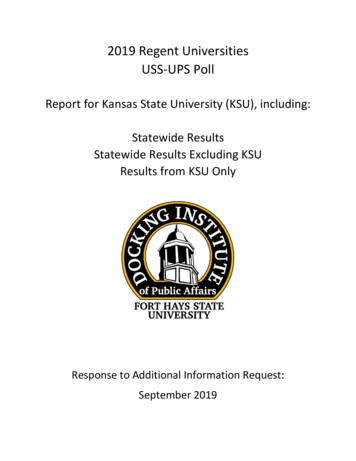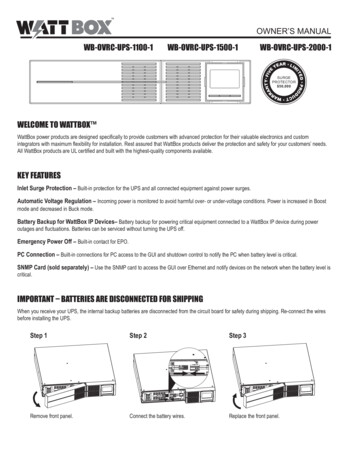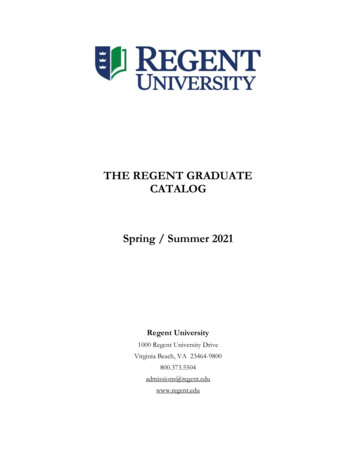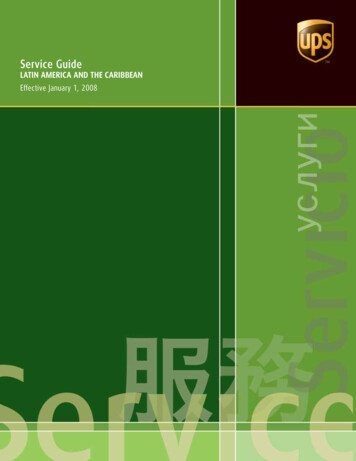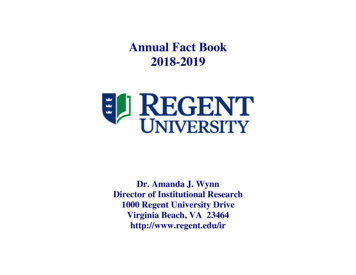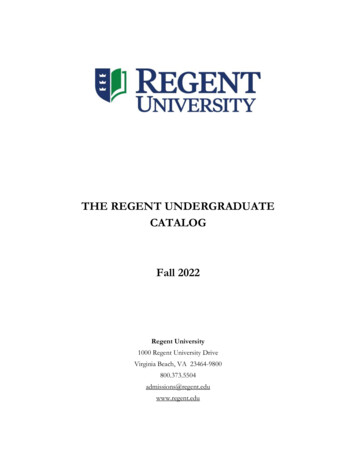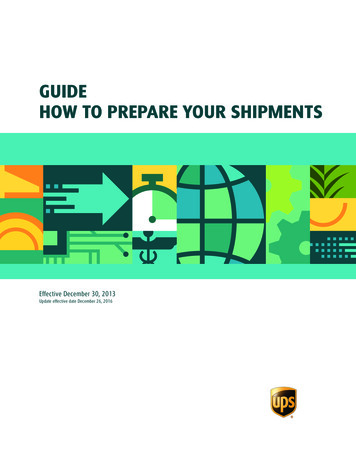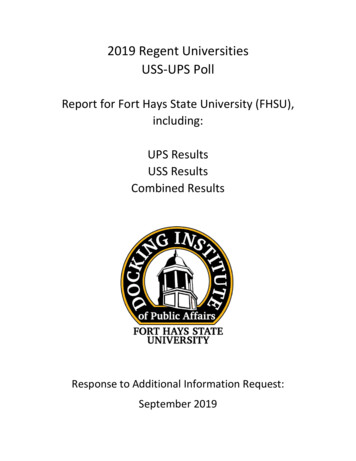
Transcription
2019 Regent UniversitiesUSS-UPS PollReport for Fort Hays State University (FHSU),including:UPS ResultsUSS ResultsCombined ResultsResponse to Additional Information Request:September 2019
Docking Institute of Public AffairsFort Hays State University600 Park StreetHays, Kansas 67601-4099Telephone: (785) 628-4197FAX: (785) 628-4188www.fhsu.edu/dockingBrett Zollinger, Ph.D.DirectorJian Sun, Ph.D.Assistant DirectorMichael S. Walker, M.S.Research ScholarLuis Montelongo, M.B.ASurvey Center ManagerLynette Ottley, B.A.Administrative SpecialistMission:To Facilitate Effective Public Policy Decision-Making.The staff of the Docking Institute of Public Affairs and itsUniversity Center for Survey Research are dedicated toserving the people of Kansas and surrounding states.
2019 Regent UniversitiesUSS-UPS PollReport for Fort Hays State University (FHSU),including:UPS ResultsUSS ResultsCombined ResultsPrepared By:Michael S. WalkerDocking Institute of Public AffairsCopyright September 2019All Rights Reserved
ContentsContents . iIntroduction . 1Introduction . 1Methods . 1Summary . 2Findings. 4Table 1: Years of Employment . 4Item Importance and Appreciation of Work Performance . 5Figure 1: Item Ranking . 5Figure 2: Appreciation of Work Performed . 6Work Morale . 7Figure 3: Morale at Work . 7Figure 4: Morale Compared to Two Years Ago . 8Figure 5: Why Morale Has Worsened . 9Wages and Second Job . 10Figure 6: Perception of Current Wages. 10Figure 7: Have Second Job or Other Income. 11Figure 8: Considering a Second Job . 12Figure 9: Reasons for a Second Job. 13Figure 10: Reasons for Continued University Employment . 14Job Satisfaction, Incentives, and Health Insurance . 15Figure 11a: Job Satisfaction (FHSU UPS) . 15Figure 11b: Job Satisfaction (FHSU USS) . 16Figure 11c: Job Satisfaction (ALL FHSU) . 16Figure 12a: Incentives or Opportunities (FHSU UPS) . 17Figure 12b: Incentives or Opportunities (FHSU USS) . 18Figure 12c: Incentives or Opportunities (ALL FHSU) . 18Table 2: Additional Incentives or Opportunities . 19Figure 13: Opinions about Health Insurance . 20Budget Limitation Impacts . 21Figure 14: Opinions about Budget Limitation Impacts . 21Docking Institute of Public Affairs: Fort Hays State University USS-UPS Comparisonpg. i
Table 3: Additional Budget Impact Comments . 22Different Job . 23Figure 15: Looking for Different Job . 23Figure 16: Looking for On- and/or Off-Campus Job . 24Table 4: Additional Comments. 25Appendix: Survey . 26Docking Institute of Public Affairs: Fort Hays State University USS-UPS Comparisonpg. ii
IntroductionIntroductionUniversity Support Staff (USS) Senates of five Regent Universities asked the Docking Institute ofPublic Affairs to conduct a poll of USS and Unclassified Professional Staff (UPS) employees. Thefive universities included Emporia State University (ESU), Fort Hays State University (FHSU),Kansas State University (KSU), Pittsburg State University (PSU), and Wichita State University(WSU). 1The poll was conducted using Qualtrics on-line survey software. Email addresses for USS andUPS employees employed at the five universities during the spring 2019 semester wereprovided to the Docking Institute. Requests (including a link to an online poll) were emailed toall USS and UPS employees. The research project was submitted to the FHSU InstitutionalReview Board (IRB) for review.Poll questions were developed in collaboration with USS Senates. The poll instrument can befound in the Appendix.This report shows results from FHSU UPS respondents, FHSU USS respondents, and ALL FHSUrespondents.MethodsEmails were sent to 8,043 USS and UPS employees at the five universities. The Institutereceived 2,846 completed interviews, a response rate of 35.4%. Since the lists provided by eachuniversity included all USS and UPS employees, no margin of error is calculated.The initial email was sent on March 18, 2019. Additional email requests were sent to nonresponding employees on March 21, March 26, and April 1. Wichita State provided additionallists of UPS employees on March 28 and April 2. Follow-up emails were sent on April 1 and April9, respectively.Regarding Fort Hays State University, emails were sent to 568 USS and UPS employees. TheInstitute received 299 completed surveys. More than half (184) were UPS employees, and lessthan half (111) were USS employees. Four respondents did not provide their type ofemployment.Data were downloaded into SPSS software for analysis. Email addresses and the names ofemployees were deleted from the SPSS file before analysis began. Only grouped data wereanalyzed, and no attempt was made to link individual responses to individual respondents.1The University of Kansas was invited to participate but declined to do so.Docking Institute of Public Affairs: Fort Hays State University USS-UPS Comparisonpg. 1
SummaryThis report is for Fort Hays State University. Responses to each question on the USS-UPSEmployee poll conducted in spring 2019 are provided for UPS, USS, and ALL FHSU respondents.In most cases, responses from these three groups of respondents are shown in a table or figure.For lengthier sets of series questions, three figures are provided (FHSU UPS, FHSU USS, and ALLFHSU).The Docking Institute’s independent analysis of the data set shows the following: A larger percentage of UPS than USS respondents have worked for 0-4 years, while largerpercentages of USS than UPS respondents have worked for 15-19 years and 20 or moreyears.When asked to rank (from first to fourth) the importance of various items, “amount of payor compensation” was ranked first among most respondents. Larger percentages of UPSrespondents than USS respondents ranked “professional development” first or second,while a larger percentage of USS respondents than UPS respondents ranked “additionalperks” second.Regarding work appreciation, most respondents report that their “work is greatlyappreciated” by their immediate supervisors and co-workers. Most UPS respondents alsoreport that their “work is greatly appreciated” by department heads.Regarding work morale, most FHSU respondents rate their morale as at least “somewhatpositive.” UPS respondents provide a larger percentage of “extremely positive” responses,while USS respondents provide a larger percentage of “somewhat negative” responses.A larger percentage of UPS respondents than USS respondents report that their morale has“improved” from two years ago.A larger percentage of UPS than USS respondents provide “additional work duties with noor minimal pay increases” as a reason for worsened morale. Larger percentages of USS thanUPS respondents provide “salaries have not kept up with costs” and “morale of thosearound me has worsened” as reasons for worsened morale.A larger percentage of UPS respondents than USS respondents find their wages“reasonable.” A larger percentage of USS than UPS respondents find their wages“unreasonable.”A larger percentages of USS respondents than UPS respondents report “having a second jobor other means of income.” When asked about “considering taking a second job,” responsesfrom UPS and USS respondents do not differ.When asked to provide reasons for having or considering a second job, larger percentagesof UPS respondents than USS respondents report doing so to “pay down debts/bill” and“better provide for family.” A larger percentage of USS respondents than UPS respondenthave or are considering a second job to have “additional discretionary income.”Larger percentages of USS respondents than UPS respondents report that they remain attheir university because they are “close to retirement” and the “better salary than offeredin the private sector.”Docking Institute of Public Affairs: Fort Hays State University USS-UPS Comparisonpg. 2
Regarding job satisfaction, most respondents at least “agree” with four statements: “I enjoythe things I do at work,” “I am sufficiently trained to complete my duties,” “I have agenerally positive work environment,” and “I have reasonable workload.” Largerpercentages of UPS respondent than USS respondents “strongly agree” with all four ofthese statements.Regarding important incentives or opportunities, most respondents find “improved healthcare benefits” and “flex-time or flexible hours” as at least “very important.”Regarding “other” important incentives or opportunities, 11.9% of ALL FHSU respondentsidentify a “promotion schedule/merit schedule/annual raises” as an important incentive oropportunity. A much larger percentage of UPS respondents (15.2%) than USS respondents(4.8%) identify this item as an important incentive or opportunity.When asked about the value of health insurance, a larger percentage of USS respondentsthan UPS respondents report that they are “receiving equal value at more cost.”Larger percentages of UPS than USS respondents report that they are “completing moreadvanced duties and tasks” and “staff reductions” as impacts of budget limitations.When asked to provide other impacts of budget limitations, 22% of ALL FHSU respondentsidentify a “lack of funds to accomplish tasks/purchase supplies” as an impact. A much largerpercentage of USS respondents (31.3%) than UPS respondents (16.7%) identify this item asan impact of budget limitations.About the same percentages of UPS respondents and USS respondents report looking for adifferent job within the past year or so.A larger percentage of UPS respondents are looking for an off-campus job and a largerpercentage of USS respondents are looking for an on-campus job.When asked to provide additional comments, notably larger percentages of UPSrespondents than USS respondents provided comments relating to “understaffing” andoffered “favorable comments about university employment or university leadership.”Notably larger percentages of USS than UPS respondents provided comments relating to“wage increases/wage increase schedule/yearly cost of living adjustments, “generalizedfrustration/low morale,” and “wages should match skills and/or years of service.”Docking Institute of Public Affairs: Fort Hays State University USS-UPS Comparisonpg. 3
FindingsThis section of the report provides percentage responses to each question in the poll.Questions were grouped by theme and do not necessarily follow the flow of the poll questions(see Appendix A).The tables and figures below show responses for FHSU UPS respondents, FHSU USSrespondents, and ALL FHSU respondents.Table 1 shows years of employment.The table shows that a notably larger percentage of UPS respondents than USS respondents hasworked for 0-4 years. On-the-other-hand, notably larger percentages of USS respondents thanUPS respondents have worked for 15-19 years and 20 years or more.Table 1: Years of EmploymentPercentages ShownFHSU UPS(n 184)0-4 years5-9 years10-14 years15-19 years20 years or moreTotal42.418.513.06.519.6100FHSU USS(n 111)All FHSU(n ocking Institute of Public Affairs: Fort Hays State University USS-UPS Comparisonpg. 4
Item Importance and Appreciation of Work PerformanceFigure 1 shows responses to four items. Respondents were asked to rank each according toimportance from first to fourth. The items were: Recognition for the work you performAmount of pay or compensationAdditional incentives or perksProfessional development opportunitiesThe figure shows that the “amount of pay or compensation” was ranked first among most(more than 50%) respondents. A large majority (86.8%) of USS respondents ranked this itemfirst, as did 62.3% of UPS respondents.Larger percentages of UPS respondents than USS respondents ranked “professionaldevelopment opportunities” first or second.Larger percentages of USS respondents than UPS respondents ranked “additional perks” and“recognition of work” second.Figure 1: Item RankingDocking Institute of Public Affairs: Fort Hays State University USS-UPS Comparisonpg. 5
Figure 2 shows responses to statements addressing the work performance appreciation byvarious groups and individuals. The groups and individuals include co-workers, immediatesupervisors, department heads, and university administrators. The statements include “mywork is unappreciated,” “my work is moderately appreciated,” “my work is greatlyappreciated,” and “this item does not apply to me.”Figure 2 shows that most (more than 50%) of respondents report that their “work is greatlyappreciated” by their immediate supervisors and co-workers.Most (52.5%) of UPS respondents also report that their “work is greatly appreciated” by“department heads.”Figure 2: Appreciation of Work PerformedDocking Institute of Public Affairs: Fort Hays State University USS-UPS Comparisonpg. 6
Work MoraleThis section of the report addresses work morale. Figure 3 shows responses to the question“generally speaking, how do you rate your morale at work?” Answer options ranged from“extremely positive” to “extremely negative.”Figure 3 shows that most FHSU respondents (ALL FHSU) rate their morale as at least“somewhat positive” (when considering somewhat positive and extremely positive responsestogether).UPS respondents provide a larger percentage of “extremely positive” responses than USSrespondents. USS respondents, on the other hand, provide a larger percentage of “somewhatnegative” responses.Figure 3: Morale at WorkDocking Institute of Public Affairs: Fort Hays State University USS-UPS Comparisonpg. 7
Figure 4 shows responses to a question asking “compared to two years ago, would you say yourmorale has improved, remained the same, or worsened?”About two-fifths (41.2%) of ALL FHSU respondents report that their morale has “remained thesame” and 34.3% report that their morale has “improved” from two years ago.A larger percentage of UPS respondents than USS respondents report that their moral has“improved,” while a larger percentage of USS respondents than UPS respondents report thattheir morale has “worsened” from two years ago.Figure 4: Morale Compared to Two Years AgoDocking Institute of Public Affairs: Fort Hays State University USS-UPS Comparisonpg. 8
Respondents indicating that their morale has worsened compared to two years ago(represented by the grey bars in the previous figure) were asked follow-up questions about whymorale has worsened. Responses included “salary increases haven’t kept up with increasedcosts,” “had to take on additional work duties with no/minimal increases in pay,” “morale ofthose around me has worsened,” and “layoffs have created uncertainty about the future of myposition.”The figure below shows all four statements and all three groups of respondents.A larger percentage of UPS respondents than USS respondents report “additional work dutieswith no or minimal pay increases” as a reason for worsened morale.Larger percentages of USS respondents than UPS respondents report “salary increases haven’tkept up with costs” and “morale of those around me has worsened” as reasons for worsenedmorale.No FHSU respondents report that “layoffs created uncertainty about my position.”Figure 5: Why Morale Has WorsenedDocking Institute of Public Affairs: Fort Hays State University USS-UPS Comparisonpg. 9
Wages and Second JobThis section of the report addresses wages and a second job (if workers have a second joband/or if they have considered one).Figure 6 shows responses to the question “how do you rate your salary or hourly wage withregard to the work you currently perform?” Answer options ranged from “extremelyreasonable” to “extremely unreasonable.”The figure below shows that a larger percentage of UPS respondents than USS respondents findtheir wages “reasonable,” while a larger percentage of USS than UPS respondents find theirwages “unreasonable.”Figure 6: Perception of Current WagesDocking Institute of Public Affairs: Fort Hays State University USS-UPS Comparisonpg. 10
Figure 7 shows responses to a question asking “do you (yourself) have a second job or othermeans of income?”The figure shows that a larger percentage of USS respondents than UPS respondents reporthaving a second job or other means of income.Figure 7: Have Second Job or Other IncomeDocking Institute of Public Affairs: Fort Hays State University USS-UPS Comparisonpg. 11
Respondents answering “no” to the question above were asked the question “are youconsidering getting a second job (or considering some other option) to increase your income?”Figure 8 shows that responses from UPS and USS respondents are similar.Figure 8: Considering a Second JobRespondents with a second job (“yes” Figure 7) and those considering a second job (“yes”Figure 8) were asked the question “of the following, which BEST describes the reason you havetaken a second job or are considering a second job?”Answer options included to “be able to better provide for family,” “help to pay downdebts/bills,” and “be able to have additional discretionary income (i.e., to spend on vacations,upgraded car, etc.).”Docking Institute of Public Affairs: Fort Hays State University USS-UPS Comparisonpg. 12
Figure 9 shows that larger percentages of UPS respondents than USS respondents have asecond job or are considering taking a second job to “pay down debts/bills” and to “betterprovide for family.”A larger percentage of USS respondents than UPS respondents have a second job or areconsidering taking one to able to “additional discretionary income.”Figure 9: Reasons for a Second JobRespondents with a second job (“yes” Figure 7) and those considering a second job (“yes”Figure 8) were also presented with the following statement and question:“You mentioned that you have a second job or that you are considering takinga second job. Regarding your job with the University, which of the followingreasons have encouraged you to remain employed there?”Docking Institute of Public Affairs: Fort Hays State University USS-UPS Comparisonpg. 13
Respondents were presented the list of the following statements and asked if they agree ordisagree with each (recorded as “yes” or “no”). I earn a better salary than a comparable job in the private sectorThe stability in employmentI need the health insuranceI need access to the education discounts offered (i.e. tuition waivers) for self/dependentsI am close to retirement ageI enjoy the work so much that I remainFigure 10 shows the responses to these statements for UPS, USS, and ALL FHSU respondents.Figure 10: Reasons for Continued University EmploymentFigure 10 shows that slightly larger percentages of UPS respondents than USS respondentsreported that they remain at their university for the “health insurance” and “educationdiscounts.” Slightly larger percentages of USS respondents than UPS respondents report thatthey remain at their university because of the “stability of employment” and “enjoyment ofwork.”Much larger percentages of USS respondents than UPS respondents report that they remain attheir university because they are “close to retirement” and the “better salary than offered inthe private sector.”Docking Institute of Public Affairs: Fort Hays State University USS-UPS Comparisonpg. 14
Job Satisfaction, Incentives, and Health InsuranceThis section of the report addresses job satisfaction, incentives or opportunities that might beof interest to employees, and opinions about health insurance.Regarding job satisfaction, respondents were presented with a number of statements andasked to respond to each with answer options ranging from “strongly agree” to “stronglydisagree.” The statements included the following: I enjoy the things I do at workI have a generally positive work environmentI am sufficiently trained to complete my required job dutiesI have a reasonable workloadI have a fair chance of advancement in my jobI have a fair chance for future salary or wage increasesFigures 11a, 11b, and 11c show responses to the statements above. Figure 11a showsresponses from FHSU UPS respondents.Most UPS respondents (more than 50%) at least “agree” with four statements: “I enjoy thethings I do at work,” “I am sufficiently trained to complete my duties,” “I have a generallypositive work environment,” and “I have a reasonable workload.”Figure 11a: Job Satisfaction (FHSU UPS)Docking Institute of Public Affairs: Fort Hays State University USS-UPS Comparisonpg. 15
Figure 11b shows responses from FHSU USS respondents.Similarly, most USS respondents (more than 50%) also at least “agree” with four statements: “Ienjoy the things I do at work,” “I am sufficiently trained to complete my duties,” “I have agenerally positive work environment,” and “I have a reasonable workload.”Larger percentages of UPS respondents than USS respondents “strongly agree” with all fourstatements above.Figure 11b: Job Satisfaction (FHSU USS)Figure 11c shows responses from ALL FHSU respondents.Figure 11c: Job Satisfaction (ALL FHSU)Docking Institute of Public Affairs: Fort Hays State University USS-UPS Comparisonpg. 16
Figures 12a, 12b, and 12c show responses to the series statements regarding incentives oropportunities that might be of interest to employees. Respondents were asked to respond toeach with answer options ranging from “extremely important” to “not at all important.” Theincentives or opportunities are listed below: Flex-time or flexible hoursOn-the-job trainingTransportation assistance (such as a ride sharing program)Childcare assistance (such as financial assistance or care at work)Improved healthcare benefitsFigures 12a, 12b, and 12c show responses to the statements above. Figure 12a showsresponses from FHSU UPS respondents.Most UPS respondents (more than 50%) find “improved health care benefits,” “flex-time orflexible hours,” and “on-the-job training” as at least “very important.”Figure 12a: Incentives or Opportunities (FHSU UPS)Docking Institute of Public Affairs: Fort Hays State University USS-UPS Comparisonpg. 17
Figure 12b shows responses from FHSU USS respondents.Most USS respondents (more than 50%) find “improved health care benefits” and “flex-time orflexible hours” as at least “very important.”Figure 12b: Incentives or Opportunities (FHSU USS)Figures 12a and 12b show that a smaller percentage of UPS respondents than USS respondentsfind “childcare assistance” “not as all important.” On-the-other-hand, a larger percentage ofUPS respondents than USS respondents find “transportation assistance” “not at all important.”Figure 12c shows responses from ALL FHSU respondents.Figure 12c: Incentives or Opportunities (ALL FHSU)Docking Institute of Public Affairs: Fort Hays State University USS-UPS Comparisonpg. 18
Respondents were asked to provide another incentive in a text box. Table 2 shows commentscollapsed into 22 categories (ordered using the scheme provided in the initial reports). (NOTE:Some respondents provided more than one incentive or opportunity. The categories belowshow the first incentive/opportunity listed.)Table 2: Additional Incentives or OpportunitiesPercentages of ResponsesAdditional Incentives/OpportunitiesPromotion Schedule/Merit Schedule/Annual RaisesFHSU UPS(n 46)FHSU USS(n 21)ALL FHSU(n 67)15.24.811.919.0Immediate Base Pay Increase2.2Paid or Reduced Parking Fee4.33.0Tuition Assistance Improvement/Loan Repayment6.54.5Financial Incentives or Bonuses for Extra Work8.79.54.8Additional Paid Time Off/Paid During Semester Breaks6.5Working Remotely/Telecommute2.2Appreciation for Work Performed/Better Work Environment6.5Professional Development Opportunities6.5Paid or Reduced Recreation or Entertainment Fees4.3Improved Health Care Insurance8.7Retirement Plan or 401k Options/Options for Part-Time Work8.77.59.06.01.514.39.014.37.54.56.04.87.5Upper Admin. Planning/Understanding of Our Entities & Jobs2.21.5Hire Additional Staff/Fill Vacant Positions4.33.0Parent or Child Leave Policy4.81.5Other Comments2.24.83.0Four Day Work Week2.24.83.04.81.54.84.5Work Cell Phones/Work Items ProvidedFlexible Working Hours/Flex-Time4.3Time for Expercise During Workday2.21.5Reduced Fees for on Campus Meals2.24.83.0Total100100100The table above shows that 11.9% of ALL FHSU respondents identify a “promotionschedule/merit schedule/annual raises” as an important incentive or opportunity. A muchlarger percentage of UPS respondents (15.2%) than USS respondents (4.8%) identify this item asan important incentive or opportunity.Almost a fifth (19%) of USS respondents identify an “immediate base pay increase” as animportant additional incentive or opportunity. A much smaller percentages of UPS respondents(2.2%) identify the same as an important incentive or opportunity.Docking Institute of Public Affairs: Fort Hays State University USS-UPS Comparisonpg. 19
Larger percentages of USS respondents than UPS respondents identify “appreciation for workperformed/better work environment” and “paid or reduced recreation or entertainment fee”as important incentives or opportunities.Respondents were also asked to respond to the statement “with regard to your healthinsurance through the State of Kansas, which of the following statements MOST applies toyou.” The following items were provided: I'm receiving more value at more costI'm receiving equal value at more costI'm receiving less value at more costI don't feel I'm well informed enough to respondI don't use the State of Kansas Health InsuranceThe figure below shows that a larger percentage of USS respondents than UPS respondentsreport that they are “receiving equal value at more cost.” On the other hand, a largerpercentage of UPS respondents than USS respondents report that they are “not well informedenough to respond.”Figure 13: Opinions about Health InsuranceDocking Institute of Public Affairs: Fort Hays State University USS-UPS Comparisonpg. 20
Budget Limitation ImpactsThis section of the report addresses opinions about the impacts of budget limitations.Respondents were presented with the following question and statement: “Have budgetlimitations impacted your job? If so, please mark all of the areas below that have beenimpacted by budget limitations.”Respondents were then presented with a table containing the items below and asked to select“yes” or “no” to each. My amount or quantity of my work has increasedMy duties have increasedI now complete more advanced level duties/tas
Docking Institute of Public Affairs: Fort Hays State University USS-UPS Comparison pg. 2. Summary . This report is for Fort Hays State University. Responses to each question on the USS -UPS Employee poll conducted in spring 2019 are provided for UPS, USS, and ALL FHSU respondents.

